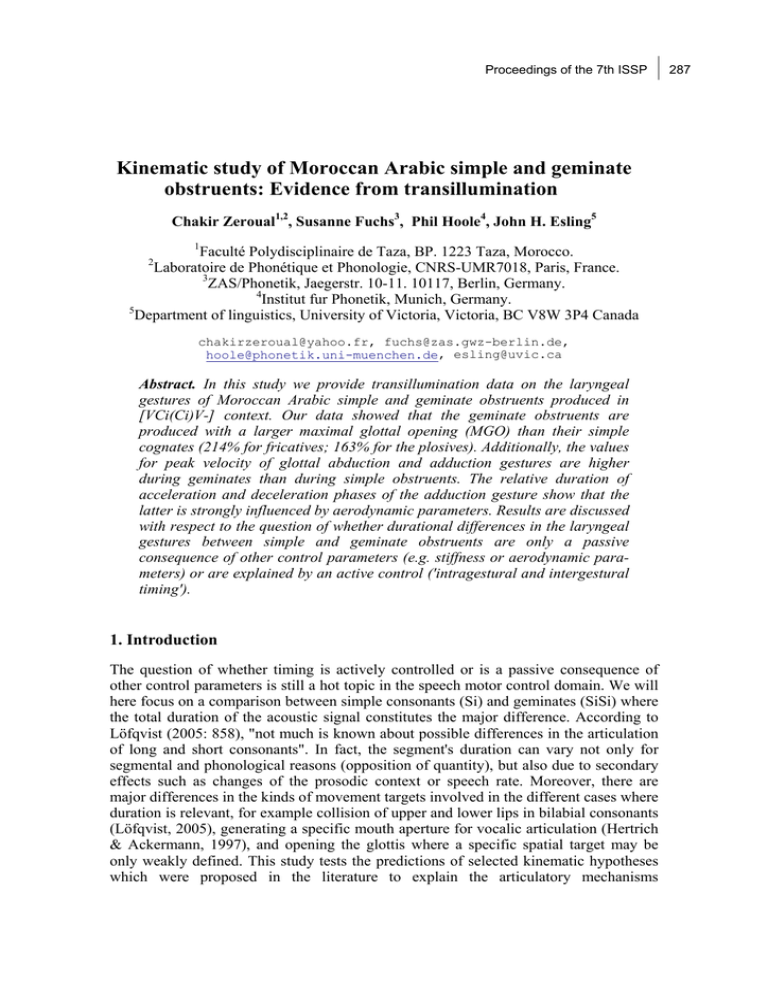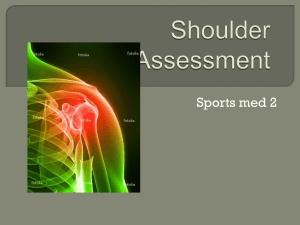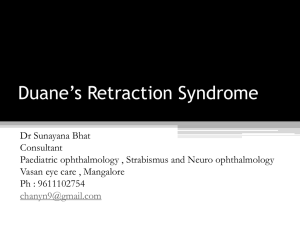Kinematic study of Moroccan Arabic simple and geminate obstruents
advertisement

Proceedings of the 7th ISSP
Kinematic study of Moroccan Arabic simple and geminate
obstruents: Evidence from transillumination
Chakir Zeroual1,2, Susanne Fuchs3, Phil Hoole4, John H. Esling5
1
Faculté Polydisciplinaire de Taza, BP. 1223 Taza, Morocco.
Laboratoire de Phonétique et Phonologie, CNRS-UMR7018, Paris, France.
3
ZAS/Phonetik, Jaegerstr. 10-11. 10117, Berlin, Germany.
4
Institut fur Phonetik, Munich, Germany.
5
Department of linguistics, University of Victoria, Victoria, BC V8W 3P4 Canada
2
chakirzeroual@yahoo.fr, fuchs@zas.gwz-berlin.de,
hoole@phonetik.uni-muenchen.de, esling@uvic.ca
Abstract. In this study we provide transillumination data on the laryngeal
gestures of Moroccan Arabic simple and geminate obstruents produced in
[VCi(Ci)V-] context. Our data showed that the geminate obstruents are
produced with a larger maximal glottal opening (MGO) than their simple
cognates (214% for fricatives; 163% for the plosives). Additionally, the values
for peak velocity of glottal abduction and adduction gestures are higher
during geminates than during simple obstruents. The relative duration of
acceleration and deceleration phases of the adduction gesture show that the
latter is strongly influenced by aerodynamic parameters. Results are discussed
with respect to the question of whether durational differences in the laryngeal
gestures between simple and geminate obstruents are only a passive
consequence of other control parameters (e.g. stiffness or aerodynamic parameters) or are explained by an active control ('intragestural and intergestural
timing').
1. Introduction
The question of whether timing is actively controlled or is a passive consequence of
other control parameters is still a hot topic in the speech motor control domain. We will
here focus on a comparison between simple consonants (Si) and geminates (SiSi) where
the total duration of the acoustic signal constitutes the major difference. According to
Löfqvist (2005: 858), "not much is known about possible differences in the articulation
of long and short consonants". In fact, the segment's duration can vary not only for
segmental and phonological reasons (opposition of quantity), but also due to secondary
effects such as changes of the prosodic context or speech rate. Moreover, there are
major differences in the kinds of movement targets involved in the different cases where
duration is relevant, for example collision of upper and lower lips in bilabial consonants
(Löfqvist, 2005), generating a specific mouth aperture for vocalic articulation (Hertrich
& Ackermann, 1997), and opening the glottis where a specific spatial target may be
only weakly defined. This study tests the predictions of selected kinematic hypotheses
which were proposed in the literature to explain the articulatory mechanisms
287
288
Zeroual et al.
responsible for timing variations linked to the phonological opposition of quantity.
According to the "mass spring model" (Kelso et al. 1986; Turvey et al., 1986),
variations in the time are passive consequences of a difference in the degree of stiffness
(hypothesis1) and are not actively controlled: compared to its short cognate, a long
segment has a lower degree of stiffness. Several measures have been proposed to
quantify the degree of stiffness. Perhaps the most commonly used one is to estimate the
gradient of the relationship between Vmax and amplitude.
Hertrich & Ackermann, 1997, found slightly shallower slopes (i.e. lower
stiffness) for long vs. short vowels in German. Löfqvist, 2005, investigated bilabial
consonants in Japanese and found higher amplitude for geminates vs. singletons but
very similar peak velocity, again suggesting lower stiffness for the longer sounds
(Löfqvist was actually principally interested in testing a rather different hypothesis,
namely that geminates are mainly controlled via a higher virtual target for the lower lip
with the expectation of a higher peak velocity, giving a longer and firmer closure).
Further issues concern the similarity of the velocity profiles of opening and
closing movements, and, moreover, the symmetry of the velocity profiles, i.e. the
relative duration of acceleration and deceleration phases. For example, Hertrich and
Ackermann, 1997 found that opening and closing gestures behave differently for the
realization of long vs. short vowels in German. Indeed, Hertrich et al. (1997: 523)
observed "a longer deceleration phase of the opening and an increased acceleration
interval of the closing movement in long as compared to short vowels" which permits,
according to these authors, to maintain the active articulator close to its target as long as
possible. Hertrich et al. (1997) attributed the lengthening of the relative acceleration
phase of the closing gesture to another type of articulatory adjustment ('intragestural
timing': hypothesis2). The lengthening of the deceleration phase is produced to avoid
truncation of the opening gesture by anticipation of the closing gesture ('intergestural
timing': hypothesis3). Although these results are obtained for movements of different
articulators, we will use these ideas as possible speech motor control principles and
examine their applicability to laryngeal movements.
These hypotheses will be discussed by focusing on the control of timing in
laryngeal gestures (abduction + adduction) of intervocalic Moroccan Arabic (MA)
simple and geminate consonants. We will also analyse the relations between kinematic
properties of the laryngeal gestures and aerodynamic parameters, since aerodynamics
plays a major role with respect to laryngeal behaviour.
2. Method
A flexible endoscope has been inserted through the nostril of a Moroccan Arabic
speaker (38 years). Two photosensors have been placed on the external surface of the
neck, PGG1 (between the thyroid and cricoid cartilages) and PGG2 (below the cricoid)
to capture the quantity of light that passes through the glottis and that is proportional to
its opening degree (Figure 1). The analysis has been made on the PGG2 signals since
they were more stable. Additionally, we recorded the endoscopy on video to provide
further qualitative evidence of glottal activity. Acoustics were recorded on DAT at 24
Proceedings of the 7th ISSP
kHz sampling frequency. The speaker repeated seven times a corpus composed of
words and nonsense words containing all MA simple consonants ([-iCi]) and geminates
([-CCi-]). We present here results for [f s x t k k ff ss xx tt kk qq].
We analyzed the audio data using Praat, the glottal aperture by means of Matlab, and
the statistics by means of StatView. Figure1 illustrates all the measures (except VOT).
Figure 1: 1: Total duration (TLD); 2: Duration of the abduction phase
(ABD); 3: Duration of the adduction phase (ADD); 4: Relative duration
of the acceleration phase (measure4/measure2) of the abduction
gesture (ACC-ABD); 5: Relative duration of the deceleration phase
(measure5/measure2) of the abduction gesture (DEC-ABD); 6: Relative
duration of the acceleration phase (measure6/measure3) of the
adduction gesture (ACC-ADD); 7: Relative duration of the deceleration
phase (measure7/measure3) of the adduction gesture (DEC-ADD); 8:
Maximal glottal opening (MGO); 9: Maximal velocity of the abduction
gesture (Vel-ABD); 10: Maximal value of the adduction gesture (VelADD).
3. Results and discussion
The interpretation of our data is based on 8 one-factor ANOVAs. The independent
variable for 7 tests is constituted by [f s x ff ss xx t k q tt kk qq] and [t k q tt kk qq] for
the eighth (figure 1). The dependent variable varies with the consonant:
(i) Four duration measures: Total Duration (TLD: [F(11, 72) = 105.484 p<0.0001]),
duration of the abduction (ABD: [F(11, 72) = 45.670 p<0.0001]) and adduction phases
(ADD: [F(11, 72) = 43.024 p<0.0001]), Voice onset time (VOT (F(5, 36) = 28.968
p<0.0001]). (ii) Four kinematic measures: Maximal glottal opening (MGO: [F(11, 72) =
39.890 p<0.0001]), Maximal velocity of abduction and adduction gestures (VEL-ABD:
[F(11, 72) = 33.212 p<0.0001]; VEL-ADD: [F(11, 72) = 35.485 p<0.0001]), and
relative duration of acceleration and deceleration phases of abduction (ACC-ABD:
[F(11, 72) = 10.750 p<0.0001]; DEC-ABD: [F(11, 72) = 10.750 p<0.0001]) and
289
290
Zeroual et al.
adduction gestures (ACC-ADD: [F(11, 72) = 18.214 p<0.0001]; DEC-ADD: [F(11, 72)
= 18.214 p<0.0001]).
3.1 Temporal results
Duration (msec)
240
210
180
150
120
90
60
30
0
f
s
DTL
ABD
ADD
VOT
x
t
k
q
ff
ss
xx
tt
kk
qq
Figure 2. Mean values of total duration (TLD); duration of the abduction
(ABD) and adduction (ADD) phases of [f s x t k q ff ss xx tt kk qq]; and
VOT of [t k q tt kk qq] in VCi(Ci)V contexts (see Fig.1).
The aposteriori PLSD Fisher tests show that TLD of the geminates is significantly
longer than that of their simple cognates (p<0.001). The adduction phase of fricatives is
longer than the abduction. The plosives have similar duration of abduction and
adduction gestures during [t k tt kk] and a shorter adduction is found during [q qq]. This
difference between [t k tt kk] and [q qq] can be attributed to the VOT which is longer
during the first than during the second (Figure 1).
3.2 Maximal glottal opening amplitude
During [f s], the MGO is identical ([f vs s] p=0.47), but significantly lower than that of
[x] (p <0.001). Our previous aerodynamic analyses (Zeroual, 2003) showed that, intervocalically, the oral airflow (U) during [x] is higher than that of [s], even though their
intraoral pressure (Po) values are not different. This result suggests that the mean crosssectional area of the supralaryngeal (dorsal) constriction is larger during [x] compared
to [s]. The larger opening of the glottis during [x] (figures 3 and 4) supports a higher
transglottal airflow in order to produce a sufficient value of Po to generate a turbulence
at the level of the supralaryngeal constriction even though the latter is large.
[t k q] possess an MGO that is statistically identical between them and to that of
[f s], but lower than that of [x] (p <0.001). The absence of difference between, for
example, [t k] and [f s] ([t vs f] p=0.88; [t vs s] p=0.38; [k vs f] p=0.66; [k vs s] p=0.47)
doesn't agree with a general tendency according to which the glottis is more open
during the fricatives that during the plosives (Hoole, 1999 for review). The fact that the
VOT of [t] (67 ms) and [k] (61 ms) is substantial may explain why the amount of the
glottal opening is identical during [t k f s].
The geminates possess an MGO that is larger than their simple correspondents
(for all Ci vs CiCi oppositions p<0.02). The ratio geminate/simple for the fricatives
(214%) is higher than for the plosives (163%). This asymmetry is in accordance with
the results of Sawashima and Miyasaki (1973) who observed that the difference
between the peak glottal opening of simple and geminate is significant for the fricatives
Proceedings of the 7th ISSP
and non-significant for the plosives. Notice that [xx] has a MGO that is larger than that
of all the other geminate consonants, even larger than that of [ff ss] (p <0.001).
2,5
2
1,5
1
0,5
0
f
s
x
t
k
q
ff
ss
xx
tt
kk
qq
Figure 3. Maximal glottal opening during simple and geminate obstruent
production: y-axis: glottal opening of PGG2 in mV, x-axis: obstruents.
Figure 4. Laryngeal postures during maximal glottal opening of simple and
geminate obstruent [t k s x tt kk ss xx]: endoscopic data.
3.3 Velocity of abduction and adduction gestures
The velocity of the abduction and adduction gestures is greater during [x] compared to
[f s] (p<0.01; p<0.01) and [xx] to [ff ss] (p<0.001; p<0.001). These results are expected,
since the MGO is larger during [x] and [xx] compared to their correspondents [f s] and
[ff ss]. Indeed, several previous articulatory analyses, show a positive linear correlation
between the values of the amplitude and the velocity.
The values of abduction and adduction Vmax of [ff ss xx] and [tt kk qq] are
statistically greater than those of their simple cognates [f s x] et [t k q] ([f] vs. [ff], [s]
vs. [ss] and [x] vs. [xx]; VEL-ABD p<0.001; VEL-ADD p<0.001; [t] vs. [tt] p<0.03,
p<0.01; [k] vs. [kk] p<0.05, p<0,011). Only the [q] vs. [qq] opposition develops
asymmetric behaviour (VEL-ABD p=0.15; VEL-ADD p<0.05). These results are also
expected, since the plosives and the geminate fricatives have MGOs that are
significantly higher than that of the corresponding singleton.
291
292
Zeroual et al.
40
35
30
25
20
15
10
5
0
VEL-ABD
VEL-ADD
f
s
x
t
k
q
ff
ss
xx
tt
kk
qq
Figure 4. Peak velocity in mV/s for the abduction (white bars) and
adduction gestures (black bars). Obstruents are given on the x-axis.
Löfqvist (2005) showed that Vmax of the lower-lip closing gesture of the
intervocalic oral and nasal geminate plosives in Japanese is generally lower (but not
significantly) than that of simple consonants, even though the amplitude of the
geminates is generally larger. This result indicates, according to Löfqvist (2005), that a
significant positive correlation between amplitude and Vmax is observed only when it is
calculated for the same gesture produced in the same context (i.e. for the simple and the
geminate analyzed separately). Similar statistical analyses carried out on our dataset
(Table 1) for the gestures of abduction and adduction show, however, that all velocity
vs. amplitude correlations are positive and significant whether they are calculated for
each context individually or for the two contexts together.
This suggests that in our data there is less difference in stiffness between
singletons and geminates than was found in Löfqvist’s study. Examining the stiffness
directly, i.e. the gradient of the velocity-amplitude relation, we actually found a
significant difference contrary to the expected direction of lower values for the
geminates. In view of possible non-linearities in the transillumination signal it might be
hazardous to assume that geminates genuinely show higher stiffness. However, at least
it appears very unlikely that their longer duration is regulated via lower stiffness.
Abduction
Adduction
[f s x t k q]
0.871
0.878
[ff ss xx tt kk qq]
0.968
0.975
[f s x ff ss xx t k q tt kk qq]
0.962
0.973
Table 1: Values for the Pearson correlation coefficient (r) between peak
glottal opening (OGM) and peak velocity in the abduction and adduction
gestures calculated for the different obstruent groups (column 2-4); All data
are significant at p<0.001.
3.4 Relative duration of acceleration and deceleration phases.
For the abduction movement, the predominant pattern was that the acceleration phase
was shorter than the deceleration phase (figure 5). This applied to both single and
geminate fricatives, and to single plosives. The only exceptions to this were the two
geminate plosives /tt/ and /kk/ where acceleration and deceleration were fairly similar in
Proceedings of the 7th ISSP
duration. For the adduction movement the relative durations of acceleration and
deceleration were very similar, with only single /q/ being a major exception.
Larynx movements thus appear to behave differently from e.g. the vowel-related lip
movements studied by Hertrich & Ackerman: They found quite a clear mirror-image
pattern with relative duration of the acceleration phase longer for the short vowels on
the opening movement (assuming this to correspond to abduction in our case), but
longer for the long vowels on the closing movement (see also Hoole & Mooshammer,
2002, for similar findings). The fact that we found clearest departures from a
symmetrical velocity profile for fricatives in general, together with the short plosives,
may reflect the aerodynamic requirements for fast initiation of glottal abduction:
geminate plosives on the other hand, may simply be the sound category with the
weakest constraints on initiation of this movement.
Figure 5. Mean values of the relative duration of (a) the acceleration (ACCABD) and deceleration (DEC-ABD) phases of the abduction gesture and of
(b) the acceleration (ACC-ADD) and deceleration (DEC-ADD) phases of the
adduction gesture in [VCi(Ci)V] contexts for all obstruents.
The adduction gesture of [q] has a relative duration of its acceleration phase that is very
long, and a relative duration of its deceleration phase that is very short compared to [t k]
(p<0.001). It seems that these differences are indirect consequences of the aerodynamic
factors. Indeed, the truncation of the deceleration phase of the adduction gesture during
[q] is not due to an adjustment of intergestural timing, but to the fact that Po lowers
more quickly during [q] compared to [t k] (Zeroual, 2002). The longer duration of the
acceleration phase of the adduction gesture is not due to an adjustment of intragestural
timing, but to the adduction that begins before the oral release during [q] (-23ms) and at
the moment of the oral release (-4ms; -7ms) during [k t] (Zeroual et al. 2006). Indeed,
the adduction of the glottis, which starts at the moment of the release during [t k], is
accelerated by the decrease of the Po.
Compared to [ff ss], [xx] possesses a relative duration of the deceleration phase of its
abduction gesture that is statistically identical to that of [ff ss] ([xx] vs. [ff] p=0.37; [xx]
vs. [ss] p=0.29), the relative duration of the acceleration phase of its adduction gesture
is longer ([xx] vs. [ff] p<0.01; [xx] vs. [ss] p<0.001). We suggest that this second
difference is bound to the fact that the MGO is larger during [xx]. It seems that [xx]
293
294
Zeroual et al.
involves a supplementary adjustment of the intragestural timing that permits
lengthening the acceleration phase of its adduction gesture to maintain the glottis very
open.
4. Conclusion
This study dealt with the laryngeal kinematic parameters which contribute to the
phonological opposition of quantity between intervocalic simple and geminate
Moroccan Arabic obstruents. Our main results showed that the obstruents are produced
with a larger maximal glottal opening (MGO) than their simple cognates. This ratio is
(214%) for fricatives and (163%) for the plosives. The values of maximal velocity of
abduction and adduction gestures are higher during geminate than during simple
obstruents. This result is expected since velocity and amplitude are generally positively
correlated. The relative durations of the acceleration and deceleration phases of the
adduction and abduction gestures are strongly influenced by aerodynamic constraints.
Our data show that timing is not only a passive consequence of other control parameters
such as stiffness or aerodynamic parameters but can also be actively controlled
('intragestural and intergestural timing').
References
Parush, A., Ostry, D.J., & Munhall. K.G. A kinematic study of lingual coarticulation in
VCV sequences. The Journal of the Acoustical Society of America. 74 (4) : 11151125, 1983.
Hertrich, I., & Ackermann, H. Articulatory control of phonological vowel length
contrasts: Kinematic analysis of labial gestures. The Journal of the Acoustical
Society of America. 102(1):523-536, 1997.
Hoole, P. "Laryngeal Coarticulation. Section A: Coarticulatory investigations of the
devoicing gesture". In: W.H. Hardcastle & N. Hewlett (eds.), Coarticulation: Theory,
Data and Techniques. Cambridge University Press, pp. 105-121, 1999.
Hoole, P. & Mooshammer, C. (2002). “Articulatory analysis of the German vowel
system”. In: P. Auer, P. Gilles & H. Spiekermann (eds.), Silbenschnitt und
Tonakzente. Niemeyer, Tübingen, pp. 129-152.
Löfqvist, A. Lip kinematics in long and short stop and fricative consonants. The Journal
of the Acoustical Society of America, 117(2): 858-878, 2005.
Sawashima. M., & Hirose. H. Glottal Opening for Japanese Voiceless Consonants. Ann.
Bull. RILP 7: 1-9, 1973.
Zeroual, C., Hoole, P., & Fuchs, S. Etude par transillumination des consonnes
occlusives simples et géminées de l'arabe marocain. Proceeding of the XXVIth
Journées d'Etudes sur la parole, 2006.
Zeroual, C. Aerodynamic study of Moroccan Arabic guttural consonants. Proceedings
of the XVth ICPhS Barcelona, pp. 1859-1862, 2003.


